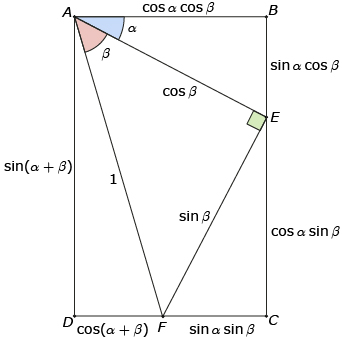Lesson 4
1. Lesson 4
1.2. Explore
Module 5: Trigonometry Applications and Identities
Explore

In Try This 1 you may have drawn a diagram similar to the diagram shown here.
By recognizing that AD = BE + CE, you can predict the identity sin (α + β) = sin α cos β + cos α sin β. Similarly, because AB = DF + CF, cos α cos β = sin α sin β + cos (α + β). This second identity is often rewritten as cos (α + β) = cos α cos β − sin α sin β. These two identities are called sum identities. In Try This 2 you will use the sum identities to predict other identities.
Try This 2
- Explain why sin (−x) = −sin x and cos (−x) = cos x are identities.

-
Use the sum identity sin (A + B) = sin A cos B + cos A sin B, and the identities from question 1 to show that sin (A − B) = sin A cos B − cos A sin B.


- Using a procedure similar to that of question 2, predict an identity for cos (A − B).



-
Consider the special case where A = B for the identities sin (A + B) = sin A cos B + cos A sin B and cos (A + B) = cos A cos B − sin A sin B. Write simplified equivalent expressions for sin 2A and cos 2A.



![]() Save your answers in your course folder.
Save your answers in your course folder.
Two possible identities are
For the cosine sum, begin with
For the sine sum, begin with
Replacing every B with −B still makes the identity true.